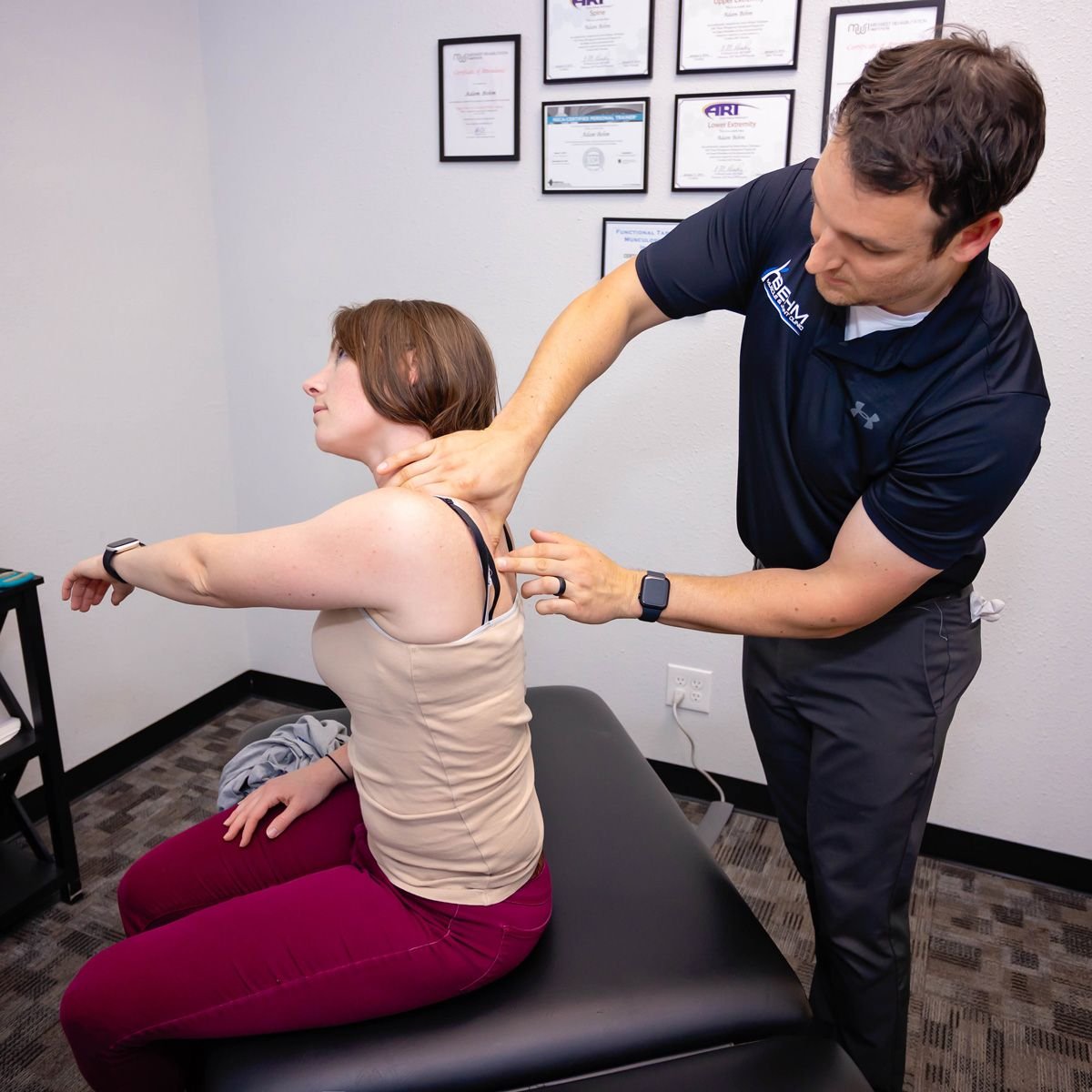Physical Therapy
Sports Medicine & Rehabilitation
Best Physical Therapy in NYC | Sports Rehab & Manual Therapy
Get top sports physical therapy in NYC. Expert manual therapy, active release techniques & rehab for pain relief. Book your session today!
Manual Physical Therapy
Physical therapy is administered by licensed professionals to help ease pain and restore the function of an injured area. Physical therapists utilize various modalities...
Functional manual therapy adopts an integrative approach aimed at strengthening and treating the entire body, with a focus on the core. By going beyond traditional exercises and hands-on therapy, this method seeks to unlock additional benefits by enhancing core strength, engagement, and proprioceptive awareness.
Advanced manual therapy involves the skilled manipulation of joints, soft tissues, and fascia to enhance movement. This hands-on approach incorporates various techniques such as soft tissue mobilization, traction, joint mobilization, manipulation, passive range of motion, movement with mobilization, and proprioceptive facilitation for maximum benefit.
Orthopedic manual physical therapy is a specialized branch of physical therapy targeting neuro-musculoskeletal conditions. Patients with such conditions often benefit from tailored treatments including reeducation programs, hands-on mobilization and manipulation, passive movements, resistance muscle activation, and personalized exercise regimens to restore full, pain-free movement.
Manual Therapy FAQ
-
We recommend comfortable clothing that allows for easy movement, especially considering your specific area of concern. For example, shorts are optimal for knee injuries, while a tank top may be preferable for shoulder injuries to facilitate hands-on care and visual inspection.
-
Your initial appointment includes a comprehensive health history review, focusing on your area of concern. Bringing notes and information on current prescriptions can be helpful. Expect a physical examination, possibly including manual therapy, massage, exercises, and assessment of range of motion and pain levels.
-
Manual therapy involves hands-on techniques for manipulating the body, which may include joint mobilization, resistive techniques, and stretching. It targets areas of injury or pain, aiming to address the underlying problem comprehensively.
-
While discomfort may be experienced during manual therapy, it should not cause significant pain. Communication with your therapist is key to adjusting the approach if discomfort arises. Discomfort is often part of the process of building muscle, flexibility, and mobility.
-
The duration of manual therapy depends on your specific condition and compliance with prescribed exercises and care. Your therapist can provide a rough estimate of the timeline during your visit, as treatment plans are customized to individual needs.
Active Release Technique (ART) Physical Therapy
ART physical therapy encompasses a range of techniques designed to target soft tissue and alleviate tension by addressing fibrosis or adhesions that develop due to overloading or repetitive motions. These adhesions can manifest as muscle weakness, numbness, aching, tingling, burning sensations, and pain. Our proficient ART providers possess a profound understanding of the adverse changes that can affect soft tissues. Recognizing that injuries extend beyond bones and joints, we offer a comprehensive treatment approach with broader and more impactful outcomes. While prompt intervention is ideal for addressing these injuries, delayed care can still yield effective results. When incorporated into a physical therapy regimen, ART serves three primary purposes:
Restore motion to all soft tissues by eliminating impingement and adhesions.
Release entrapped nerves, vasculature, and lymphatic structures.
Re-establish optimal function of soft tissue, promoting resilience and texture.
What is the Mechanism of Action for Cupping Treatment?
Cupping therapy, a time-honored method for pain relief, has roots in ancient Chinese, Egyptian, and Middle Eastern alternative medicine practices. This technique involves placing cups on the skin to create suction, effectively alleviating both chronic and acute pains, soothing trigger points, reducing inflammation, and relaxing spastic muscles. Additionally, as a form of massage therapy, cupping aids in
How Cupping Treatment Works: Cupping treatment involves placing cups directly onto the skin, either through heating or suction methods. These cups remain in position for several minutes, exerting traction on the skin, fascia, and muscles. Unlike conventional
Cupping is non-invasive and typically results in minor bruising and skin irritation, both of which resolve quickly on their own. By utilizing suction to decompress muscles and connective tissues, cupping stimulates blood flow to the area
What Are the Applications of Cupping Physical Therapy?
Who can benefit from cupping therapy, and what is it used for? Virtually anyone can derive some benefit from cupping, particularly those experiencing muscle aches and pains. However, within the realm of physical therapy, cupping serves specific purposes. If you have been prescribed this treatment or are using it for a particular medical condition, it's essential to ensure you're seeking cupping physical therapy rather than just an adjunct to massage.
Cupping is renowned for its effectiveness in providing relief for various conditions, including:
Shingles
Facial paralysis
Cough and lung congestion
Back pain
Neck pain
Myofascial pain syndrome
Individuals with trigger points
Arthritis
Knee pain
Headaches and migraines
It's worth noting that cupping can also be beneficial for individuals recovering from muscle injuries who seek to expedite healing in the affected area. In such cases, cupping is typically combined with other forms of physical therapy to maximize results.
While some suggest cupping therapy in NYC for weight loss, scientific evidence supporting this claim is lacking. However, cupping can reduce inflammation and diminish the appearance of cellulite by breaking it up and releasing toxins from the body. Although these effects may create the illusion of weight loss, they can be advantageous when combined with calorie modification and exercise programs aimed at weight loss goals.
What Actions Should You Avoid Following Cupping Therapy?
After undergoing cupping therapy, it's crucial to observe certain precautions to minimize the risk of side effects and maximize the treatment's benefits. Here are some preventive measures to consider post-cupping:
Refrain from exposing the treated area to extreme temperatures. It's advisable to steer clear of hot showers, saunas, or ice baths immediately after cupping to reduce the risk of further skin irritation or injury.
Avoid excessive physical exertion. Steer clear of strenuous exercise or activities for at least 24 hours following cupping to prevent additional strain or damage to the treated area and allow adequate time for healing.
Do not apply pressure to the cupping marks. While cupping marks may feel tender or sore, it's important to refrain from applying pressure to them to avoid aggravating the skin further.
Abstain from alcohol consumption. It's recommended to abstain from consuming alcohol for at least 24 hours after cupping to minimize inflammation or irritation within the body.
Ensure regular meals. Following cupping therapy, maintaining proper hydration and nourishment is essential. Avoid skipping meals or depriving your body of essential nutrients, as this can impede the healing and recovery process.
Should you experience any unusual or concerning symptoms such as severe pain, swelling, or signs of infection after cupping, promptly inform our doctor for further evaluation and guidance.
Schedule Your Physical Therapy Appointment Now at Infinity Therapists NYC
At Physical Therapists NYC, we hold cupping therapy in the same regard as any medical procedure or physical therapy modality. That's why our staff is extensively trained and experienced. We administer cupping when it is deemed most beneficial for the patient's care, ensuring a thorough explanation of the process to alleviate any feelings of unfamiliarity.
Our patients are our utmost priority, and our objective is to provide long-term, pain-free relief through the most effective treatment plan possible. Guided by a team of in-house medical doctors, our physical therapy experts deliver care with unparalleled experience and expertise.
Specializing in treating busy professionals, NYC Physical Therapists and Sports Medicine is strategically located in the heart of the business district. Our downtown location offers convenience for city workers and those on Wall Street, minimizing downtime in their day. To accommodate your busy schedule, we offer early morning and evening appointments. However, these time slots are highly sought-after, so we recommend scheduling today to secure your preferred time.
Equipped with state-of-the-art diagnostic tools and a fully equipped gym, our office ensures optimal conditions for your workouts and exercises. By employing the latest and best technology, we facilitate faster recovery with fewer setbacks. Moreover, we prioritize the expertise of our physical therapy staff, ensuring they are top-rated therapists and leaders in their field.
If you're currently in NYC dealing with an injury or health condition hindering your enjoyment of life, we offer safe and efficient treatment options, including cupping therapy, to enhance your health and well-being. Take control of your life by exploring whether suction cup physical therapy is suitable for you. Contact us at (212) 488-3400 today to discuss your health condition with one of our licensed therapists and embark on a meticulously tailored cupping treatment program.
To reduce pain:
Ultrasound
Electrical stimulation
Phonophoresis
Graston Technique
Iontophoresis
Cryotherapy
Kinesiotaping
Moist heat
Myofascial release
Massage
To restore function:
Therapeutic exercise
Neuromuscular reeducation
Ergonomics
Stretching & Strengthening
Manual Therapy

























